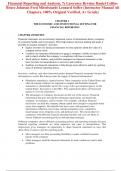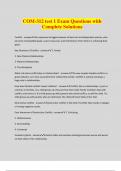Financial Reporting and Analysis, 7e Lawrence Revsine Daniel Collins
Bruce Johnson Fred Mittelstaedt Leonard Soffer (Instructor Manual All
Chapters, 100% Original Verified, A+ Grade)
CHAPTER 1
THE ECONOMIC AND INSTITUTIONAL SETTING FOR
FINANCIAL REPORTING
CHAPTER OVERVIEW
Financial statements are an extremely important source of information about a company,
its economic health, and its prospects. They help improve decision making and make it
possible to monitor managers’ activities.
• Equity investors use financial statements to form opinions about the value of a
company and its stock.
• Creditors use statement information to gauge a company’s ability to repay its debt
and to check whether the company is complying with loan covenants.
• Stock analysts, brokers, and portfolio managers use financial statements as the
basis for their recommendations to investors and creditors.
• Auditors use financial statements to help design more effective audits by spotting
areas of potential reporting abuses.
Investors, creditors, and other interested parties demand financial statements because the
information is useful. But what governs the supply of financial information?
• Mandatory reporting is a partial answer. Most companies in the United States and
other developed countries are required to compile and distribute financial
statements to shareholders and to file a copy with a government agency (in the
United States, that agency is the SEC). This requirement allows all interested
parties to view the statements.
• The advantages of voluntary disclosure are the rest of the answer. Financial
information that goes beyond the minimum requirements can benefit the
company, its managers, and its owners. For example, voluntary financial
disclosures can help the company obtain capital more cheaply or negotiate better
terms from suppliers. But benefits like these come with potential costs:
information collection, processing, and dissemination costs; competitive
disadvantage costs; litigation costs; and political costs. This means that two
companies with different financial reporting benefits and costs are likely to
choose different accounting policies and reporting strategies.
Different companies choose different accounting policies and reporting strategies because
financial reporting standards are often imprecise and open to interpretation. This
imprecision gives managers an opportunity to shape financial statements in ways that
allow them to achieve specific reporting goals.
• Most managers use their accounting flexibility to paint a truthful economic
picture of the company.
• Other managers mold the financial statements to mask weaknesses and to hide
problems.
1-1
Copyright © 2018 McGraw-Hill Education. All rights reserved. No reproduction or distribution without
the prior written consent of McGraw-Hill Education.
,Financial Reporting and Analysis 7e The Economic and Institutional Setting for Financial Reporting
• Analysts who understand financial reporting, managers’ incentives, and the
accounting flexibility available to managers will maintain a healthy skepticism
about the numbers and recognize that financial statements sometimes conceal
more than they reveal.
The accountant’s and analyst’s job is made more difficult when financial reporting
measurement and disclosure rules differ across national boundaries. Reporting rules in
some countries such as Canada, the United Kingdom, and the United States evolved to
reflect firms’ underlying economic performance. But reporting rules in many other
countries—France, Germany, and Japan, for example—merely complied with taxation or
other statutory requirements.
• Globalization forced many firms in countries using a commercial or tax law
approach to seek foreign capital. In turn, this has led countries around the world to
move to IFRS, making it easier for firms in their countries to raise capital in
domestic and foreign financial markets.
• The FASB and IASB have worked to converge the guidance for numerous
accounting issues. However, in many cases, the boards have issued substantially
different standards after having worked together originally.
CHAPTER OUTLINE
I. Why Financial Statements Are Important
Teaching Tip: While financial statements are not as timely as press releases,
they do provide an economic history and are indispensable in developing an
accurate profile of ongoing performance and prospects.
Teaching Tip: This text does not focus on assisting readers of financial
statements in detecting fraud, which is rare. Rather, the purpose of this text is to
assist readers in understanding the financial flexibility and discretion inherent in
financial accounting rules in order that they may make more informed decisions.
II. Economics of Accounting Information
A. Demand for Financial Statements
B. Disclosure Incentives and the Supply of Financial Information
III. A Closer Look at Professional Analysts
A. Analysts’ Decisions
IV. Fundamental Concepts of Financial Reporting
A. Generally Accepted Accounting Principles
B. Who Determines the Standards?
C. The Politics of Accounting Standards
D. FASB Accounting Standards Codification™
Teaching Tip: It may be a good idea to access the FASB Codification and
provide an overview of how to use the system and reinforce that everything in
the Codification is a Generally Accepted Accounting Principle.
1-2
Copyright © 2018 McGraw-Hill Education. All rights reserved. No reproduction or distribution without
the prior written consent of McGraw-Hill Education.
,Financial Reporting and Analysis 7e The Economic and Institutional Setting for Financial Reporting
V. Incentive Conflicts and Financial Reporting
Teaching Tip: For example, the choice to capitalize, rather than expense
amounts, will make firms appear to be larger, more profitable, and less risky.
Therefore, naive acceptance of financial statement data may be dangerous.
Much of the book is devoted to providing students with the skills necessary to
become more informed readers of financial statements by making meaningful
comparisons between companies and gaining insight into managers’
incentives.
VI. An International Perspective
A. International Financial Reporting
VII. APPENDIX 1A: GAAP in the United States
A. Early Developments
B. Emergence of GAAP
C. Current Institutional Structure in the United States
CHAPTER QUIZ
1. A company’s financial statements reflect information about
a. product information and competitive positions.
b. future projections of sales, expenses, and other future economic events.
c. the general economy of the industry in which the company operates.
d. economic events that affect a company that can be translated into accounting
numbers.
2. Creditors assess credit risk by comparing a firm’s required principal and interest
payments to estimates of the firm’s current and future
a. cash flows
b. net assets.
c. revenue.
d. net income.
3. Which is not correct regarding Regulation Fair Disclosure (Reg FD)?
a. It limits what management can say in private conversations with analysts and
investors.
b. It does not limit what management can say in private conversations with analysts
or investors.
c. It was passed by the SEC.
d. It helps level the playing field between individual and institutional investors.
4. Being verifiable and neutral is part of what makes financial information
a. consistent.
b. comparable.
c. relevant.
d. useful
1-3
Copyright © 2018 McGraw-Hill Education. All rights reserved. No reproduction or distribution without
the prior written consent of McGraw-Hill Education.
, Financial Reporting and Analysis 7e The Economic and Institutional Setting for Financial Reporting
5. Financial information capable of making a difference in a decision is
a. relevant.
b. reliable.
c. consistent.
d. verifiable.
6. Factors that may influence a decision maker’s judgment as to what accounting
information is useful include:
a. The decision to be made.
b. The information already possessed.
c. The decision maker’s capacity to process the information.
d. All of the above answers are correct.
7. Which one of the following types of disclosure costs is the cost of disclosing the
company’s pricing strategies?
a. Political cost
b. Litigation cost
c. Competitive disadvantage cost
d. Information collection, processing, and dissemination cost
8. Employees demand financial statement information because the firm’s performance is
often linked to
a. Employee stock ownership plans.
b. Social security benefits.
c. Disability plan benefits.
d. Workmen’s compensation benefits.
9. The primary current source of generally accepted accounting principles for
publicly traded companies in the United States rests with the:
a. Securities and Exchange Commission.
b. New York Stock Exchange.
c. Financial Accounting Standards Board.
d. American Institute of Certified Public Accountants.
10. International accounting standards are established by the
a. Securities Exchange Commission
b. London Stock Exchange
c. International Accounting Standards Board
d. Institute of Chartered Accountants
Essay Questions
1. Define the expanded role of the PCAOB in the preparation of consistent and
transparent financial statements.
2. Why would it be beneficial to narrow international differences in accounting rules for
accounting and reporting?
1-4
Copyright © 2018 McGraw-Hill Education. All rights reserved. No reproduction or distribution without
the prior written consent of McGraw-Hill Education.





